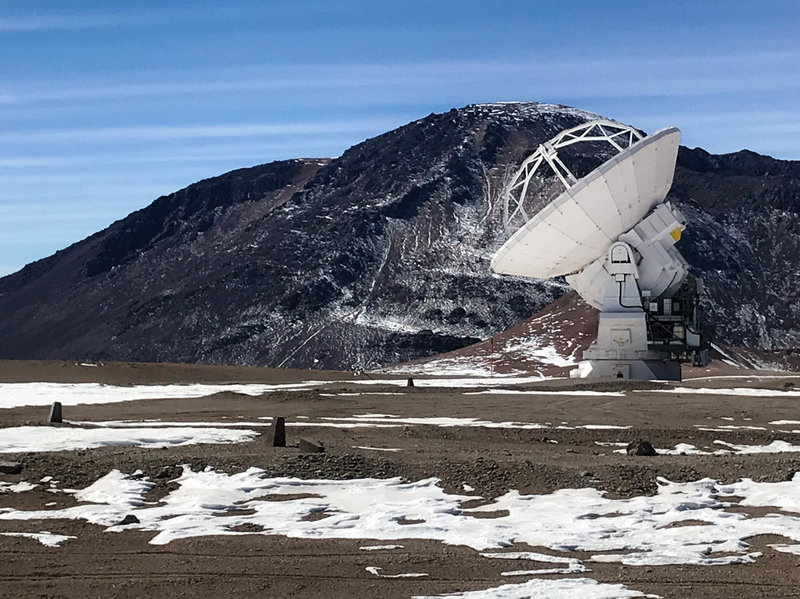
On July 2, the path of a total solar eclipse took it over the Cerro Tololo Inter-American Observatory. Even though that observatory is designed to study the night sky, it nonetheless made an idea spot to watch the Moon’s shadow sweep east across the nearby Pacific Ocean.
While in Chile to cover the eclipse, I decided to visit some of the many other observatories that have made their home in the Chilean mountains. I picked three. Here’s a snapshot of what they do and what makes them so valuable to the worlds of astronomy and astrophysics.
The Atacama Large Millimeter Array (ALMA)
The ALMA telescopes look like large steerable satellite dishes. The dishes aren’t all packed together. Any two of them can be as much as 10 miles apart.
They’re in a part of the Atacama Desert that’s about 16,000 feet above sea level. The thin air there makes it hard for humans to work, so ALMA’s main control room is at a lower altitude, a mere 9,500 feet above sea level.
“In the control room what we do is to operate the telescope the Alma Observatory” says ALMA astronomer Ignacio Toledo. Operating the telescope means deciding what the dishes are pointing at and monitoring atmospheric conditions, especially the amount of water vapor.
ALMA can see radiation coming from things like dust and gas, but water vapor acts like a cloud blocking the signal.
Toledo says more astronomers want to use ALMA than the facility can accommodate each year.
“In total, they were requesting around 16,000 hours, and we can only give 4,000,” he says. “So they do a selection based on the scientific merits of the project.”
The day I was there, David Principe, an astronomer at the MIT Kavli Institute for Astrophysics and Space Research, was the lucky winner.
Principe had ALMA point to a bright young star because he studies star formation.
In those early stages, the star is surrounded by a thick ring of dust, something that ALMA is particularly good at seeing.
“This ring is ultimately where planets are forming,” Principe says. You can’t actually see the planet, but you can see a gap in the ring where the planet’s gravity has cleared away the material.
Like almost all of ALMA’s users, Principe didn’t travel to the observatory when his measurements were being made. At some point, he’ll receive a large data file containing his results that he can study on a computer in his office.
ALMA astronomer Ignacio Toledo says this remote capability takes some of the magic out of observing with a telescope.
“It’s less romantic, yes,” Toledo says. “But at least for me and I think for most of the people here, they work in this feeling that what we’re doing is something awesome.”
The Cosmology Large Angular Scale Surveyor (CLASS)
CLASS is located on top of Cerro Toco in the Atacama Desert, one of the driest places on Earth. And at roughly 17,000 feet above sea level, it’s one of the highest telescopes in the world.
“The No. 1 science goal of CLASS is to detect evidence for these quantum gravitational waves,” says Tobias Marriage, an astronomer at Johns Hopkins University and one of the principal scientists on CLASS.
Theories say quantum gravitational waves were generated as the universe blinked into being. Finding them is key to explaining why the universe expanded the way it has. CLASS won’t see the waves themselves, but rather the traces of the waves left behind in what’s called the cosmic microwave background.
“It’s like looking at the sand at the edge of the beach when a wave comes in and the wave goes out, and you can see in the sand that a wave was there,” Tobias says.
These traces are very faint and hard to separate from the background noise of the universe. Finding them won’t be easy.
“It’s going to take many, many years,” Tobias says.
But he is ready to wait.
The Large Synoptic Survey Telescope (LSST)
The LSST is a survey telescope that’s largely funded by the National Science Foundation. Right now, the telescope is still under construction, but in a few years, it will look at huge swaths of the sky. The expectation is that it will spot rare events that are presently hard or impossible to find.
The telescope is on a peak called Cerro Pachón, about 9,000 feet above sea level.
“The science will begin on Oct. 1, 2022,” says Robert Blum, systems operations manager for the telescope. He says all the bits of the telescope are finished or nearly so. The giant mirrors for capturing and focusing starlight are on site, and the main telescope structure is on its way from Spain. The giant camera that will image the heavens is being finished at the Department of Energy’s SLAC National Accelerator Laboratory in California.
“I think everyone has great confidence that we’ve solved all the really hard technical problems, and now it’s just a matter of schedule and putting things together,” Blum says. “It’ll be a challenge but we’ll do it.”
Caltech astronomer Mansi Kasliwal says LSST will be particularly useful for finding very bright, very short-lived objects.
“It could be two very dense stars merging, for example, it could be two white dwarfs merging,” she says.
Although LSST will detect these events, other telescopes are better suited to study them in detail. So the plan is to send out an alert to other telescopes when LSST sees something interesting.
Of course, that means the other telescope operators have to drop what they’re doing. But Kasliwal says it will be worth it.
“Because you have this short window of opportunity,” she says. “You want to make the most of what the universe wants to tell you before that flash of light fades away and is gone forever.”
